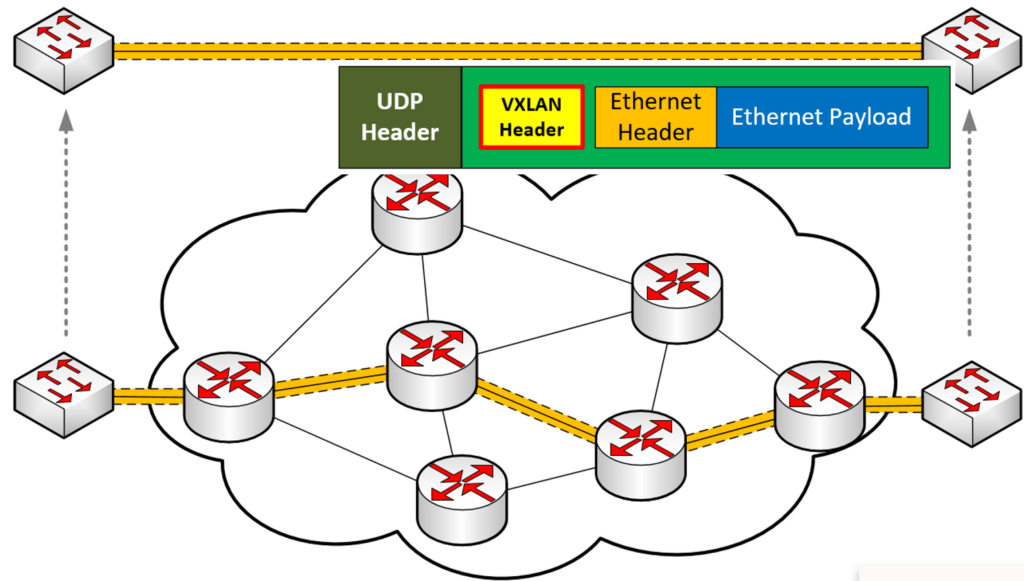Virtual Extensible LAN (VXLAN) is a network virtualization technology that addresses the scalability limitations of traditional Layer 2 networking. It is designed to extend Layer 2 networks over Layer 3 infrastructures, making it particularly useful for large-scale data centers and cloud computing environments. So let’s explore what is VXLAN, why it is needed, its benefits, and how it functions.
Why is VXLAN Needed?
VXLAN was developed to solve several critical problems that arise in traditional networking, particularly in large-scale and cloud-based environments. These issues include VLAN scalability limitations, inefficiencies in spanning tree protocols, and challenges associated with MAC address table sizes.
VLAN Scalability Limitations
Most networks, whether small or large, are divided into Virtual LANs (VLANs), which segment network traffic into separate domains. VLANs are crucial for network design, as they help in organizing traffic based on department, function, or location. VLANs are identified using a VLAN ID, which is a 12-bit number, allowing for a maximum of 4,096 VLANs in a network.
While this limit is sufficient for most enterprise networks, it becomes problematic in large data centers and cloud infrastructures where thousands of virtual machines (VMs) may be deployed. Public cloud services like Amazon Web Services (AWS), Google Cloud, and Microsoft Azure host thousands of customers, each requiring multiple Layer 2 segments. In these environments, the traditional VLAN ID limit becomes a bottleneck, making a more scalable solution like VXLAN necessary.
Datacenters and the Cloud
With the rise of cloud computing and large-scale data centers, the demand for more VLANs has surged. Cloud environments require extensive network segmentation to support thousands of customers, making the 4,096 VLAN limitation insufficient. VXLAN addresses this issue by significantly increasing the number of available Layer 2 segments.
It extends the available VLANs by using a 24-bit VXLAN Network Identifier (VNI), which allows for up to 16 million unique network segments. This vastly exceeds the 4,096 VLAN limit, making it a preferred choice for cloud providers and large data centers.
Spanning Tree Limitations
Traditional Layer 2 networks rely on Spanning Tree Protocol (STP) to prevent network loops. While effective, STP has significant drawbacks, particularly in large-scale deployments.
STP detects loops in a Layer 2 network and disables redundant links to prevent broadcast storms. However, this means that some network links remain idle unless a failure occurs. In smaller networks, this inefficiency is negligible, but in large-scale data centers, it results in massive bandwidth wastage.
Consider a cloud environment with thousands of high-speed links operating at 10, 40, or 100 Gbps. If a significant portion of these links remain idle due to STP, the wasted bandwidth translates into substantial financial losses. VXLAN eliminates this inefficiency by enabling all available network links to be used effectively, ensuring maximum utilization of bandwidth.

MAC Address Table Sizes
In highly virtualized environments, a single physical server may host hundreds of virtual machines or containers, each with its own MAC address. This significantly increases the number of MAC addresses a switch needs to learn and store.
As multiple racks of servers connect to top-of-rack switches, the number of MAC addresses continues to grow, potentially overwhelming the memory capacity of the switches. VXLAN addresses this challenge by encapsulating Layer 2 traffic within Layer 3 packets, reducing the need for switches to maintain large MAC address tables.
What is VXLAN?
VXLAN is a network virtualization technology that enables the extension of Layer 2 networks over Layer 3 infrastructures. It introduces an overlay network concept, allowing multiple Layer 2 segments to exist within a larger Layer 3 framework.
VXLAN Overlay and Underlay Networks
At the core of VXLAN is the distinction between overlay and underlay networks:
- Overlay Network: The virtual network that runs on top of the physical infrastructure. It is responsible for encapsulating Ethernet frames within UDP packets.
- Underlay Network: The physical network responsible for transporting VXLAN-encapsulated packets between different endpoints.
The underlay network operates purely at Layer 3, using routing protocols like OSPF or EIGRP to efficiently forward packets. This separation ensures that changes in the overlay network do not affect the underlay network, making it highly flexible and scalable.
How VXLAN Works
VXLAN functions by encapsulating Layer 2 Ethernet frames inside UDP packets, which are then transported over the Layer 3 infrastructure. This process enables seamless communication between devices across different physical locations without being constrained by traditional network topology limitations.
Each VXLAN segment is identified by a unique VXLAN Network Identifier (VNI), which serves a similar function to VLAN IDs but with a much larger address space. VXLAN tunnels are established between VXLAN Tunnel Endpoints (VTEPs), which are responsible for encapsulating and decapsulating VXLAN packets.
Key Advantages of VXLAN
- Scalability: It increases the number of available network segments from 4,096 (VLAN limit) to 16 million, making it ideal for large-scale environments.
- Efficient Link Utilization: Unlike STP, which disables redundant links, VXLAN ensures that all links remain active, improving network performance and efficiency.
- MAC Address Management: By encapsulating Layer 2 traffic, VXLAN reduces the burden on network switches, preventing MAC address table overflow.
- Network Flexibility: VXLAN allows Layer 2 networks to extend across multiple Layer 3 domains, making it easier to move virtual machines and manage resources across data centers.
Summary
VXLAN was developed to address the scalability challenges of traditional Layer 2 networks. By extending Layer 2 over Layer 3, it overcomes VLAN ID limitations, improves bandwidth utilization, and optimizes MAC address management. Its ability to create flexible, scalable, and efficient network infrastructures makes it a crucial technology for modern data centers and cloud environments.
Also read: eBGP vs iBGP – What’s the Difference?
About:
Welcome to telecomTech, where telecom and networking technologies… are simply explained! I’m Lazarus, a telecom professional with over 25 years of experience in network design, architecture, and telecom technologies. Over my career, I’ve led major projects, trained professionals, and helped countless individuals earn certifications and advance their careers.
My goal is to make networking and telecom concepts clear, practical, and engaging—the way I wish they were taught when I started learning!
Whether you’re a student, a professional growing your skills, or preparing for certifications like Cisco, telecomTech is here to guide you.
Join me as we explore telecom and networking as a lifelong passion, not just a job. Let’s make this journey of growth and discovery together!

